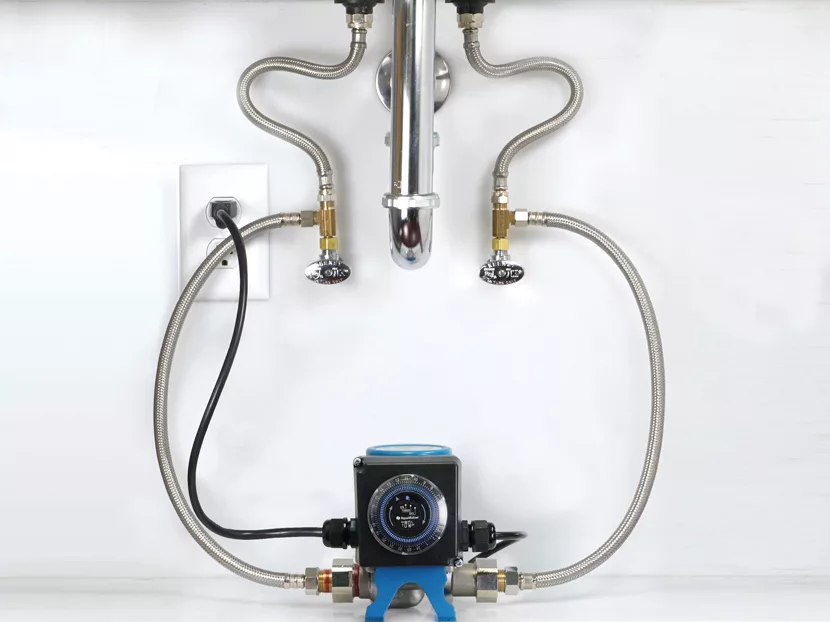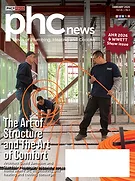The 127 million households in the United States waste annually more than 1 trillion gallons of water that was filtered and treated for human consumption. A U.S. government study of water waste per household reports approximately 7,500 to 12,000 gallons of water is lost per home with four taps. Larger homes waste even more water.
Running the faucets for one, two or three minutes while waiting for hot water to arrive at the faucet or shower is one cause of this waste.
The solution to this problem is a hot water recirculation system. It prevents this waste by bypassing the lukewarm water in the hot supply pipe into the cold water line back to the water heater instead of dumping it down the drain.
No more waiting for hot water — that is the luxury of instant hot water, a significant benefit of hot water recirculation systems.
Every home and business owner can benefit from a hot water recirculation system. These systems provide substantial financial benefits in annual cost savings through lower water bills. Water cost has increased by 8 percent/year over the last eight years and will continue to grow.
Water savings represents only a fraction of the overall savings. Sewer fees in California can cost up to two-thirds of the cost of a homeowner’s water bill.
The energy savings in gas, fuel oil or electricity are substantial when running the system only when the user needs hot water with a 24-hour timer or with a call button. Insulating pipe prevents loss of BTUs, a big energy saver. Recirculation systems can also assist in the prevention of pipe freeze-ups in the winter.
Many building codes now require a hot water recirculation system for new homes if the hot water distribution lines add up to 50 ft. Some communities set the requirement at 25 ft. The California Building Code Title 24 requires on-demand recirculation systems where the user must start the pump.
The cost of a recirculation system depends on the type of heating equipment installed in the home or business. There are kits for hot water tank systems, tankless systems, one-pipe and dedicated return-line systems. The cost ranges from $199 to $500 and offers a one-year to three-year payback.
Recirculation Technology
Today’s heating technology of hot water tanks, tankless heaters and combi units of many U.S. and foreign manufacturers requires an engineered product solution that does not affect the tank warranty. Tankless combustion rates, minimum flow rate and internal settings by different manufacturers require matched products and testing for best recirculation system performance.
Several companies make hot water recirculation systems. Make sure to select a reliable product based on how your hot water system is installed, such as AquaMotion’s Aqua-Flash and AquaMotionHot. For the best long-term performance, choose a recirculation kit listed by UL or ULC and NSF/ANSI 372 or NSF 61-certified. This certification guarantees safe, lead-free drinking water.
Select kits with stainless-steel pumps and a stainless-steel cartridge containing all the moving parts that can be pulled apart for service in calcium-rich areas. Also, stainless pumps are recyclable and help save the environment.
The bypass valve lasts longer if it is of bronze or stainless construction. Since the cost of running a recirculation system pump is only $3 to $ 8 a year, there are no real savings with an ECM pump that costs more and may be overprogrammed.
Before 1980, homes were equipped with a one-pipe system — a copper pipe from the hot water tank that connected all the faucets in sequence with hot water and ended at the last faucet. Determine if you need a kit for a one-pipe system for a hot water tank or a tankless system.
Installation Considerations
A top choice: a kit that fits under your sink in the bathroom furthest from the water heater. The pump with a built-in timer can be set in 15-minute increments for when the user wants the system to be active. The pump will sense the water temperature and turn on at 85 F and move lukewarm water into the cold pipe. As soon as 105-degree water arrives at the sink, the pump shuts off.
The pump will run about three times an hour for 1 to 1 1/2 minutes only. An electrical outlet is required. Installs by homeowner or plumber in 10 minutes; no cutting of pipe is required. Two hoses, tees and checks are included to make the bypass to the cold line.
The same kit with a larger pump and 3/4-inch hoses make this a good choice for large tanks and tankless one-pipe systems.
If there is no power under the sink, the Aqua-Flash or Grundfos bypass valve can be installed under the sink.
Few products are available for tankless water heaters. The pump is installed below the tankless. It has a unique bypass with flow control and cold connection to form a loop through the tankless unit to keep it ready to fire when the temperature setting is reached. The other bypass valve is under the sink.
For under-sink one-pipe systems that include an on-call button, the user starts the pump with a receiver and call button, motion sensor, toggle switch or a smart plug with a cell phone app.
Dedicated Return Lines
A dedicated return line is a pipe that connects the hot supply line from the last faucet back to the hot water tank. Dedicated return line products are available for hot water tank and tankless heaters.
For hot water tanks and tankless units, the pump with timer and built-in aquastat installs in the return line, 8 feet from the hot water tank. It also can be next to the tank with an external aquastat and an 8-foot cord. This system can also be made with on-call capabilities.
For tankless heaters or large tank systems, a high-performance pump with built-in timer and sensor/switch installs next to the tankless or large water heater for recirculation. This system also can be with on-call capabilities.
For tankless heaters, an on-demand or on-call system is where the user uses a wireless receiver, call button, motion sensor, toggle switch or a smart plug with a phone app to turn on the pump when hot water is required. The bypass valve is installed under the sink.
For tankless heaters with a high-performance built-in pump, an ODR bypass valve is available for homes with standard plumbing systems. The bypass valve is installed under the sink in the cold water line.
Tankless water heaters in the southern tier of the county are often installed outdoors to save on expensive air intake and exhaust system. AquaMotion’s Aqua-Shield is a new outdoor pump with an operating range of 100 F to 115 F. The outdoor box with clear cover is rain- and sprinkler-resistant, freeze- and bug-protected with anti-tampering locking feature.
Hot water recirculation in every home will save billions of gallons of water, conserve energy, reduce utility costs, provide instant hot water comfort and help reduce the water shortage in many areas of the country.




